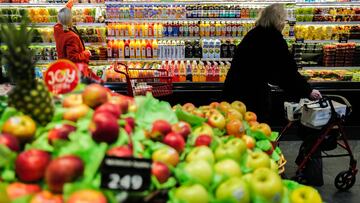SNAP coupon payment dates in February 2024 for Florida and California
State governments continue to manage the distribution of SNAP benefits. Here are the exact dates on which food stamps are sent in California and Florida.

Every month, US states send out benefits from the Supplemental Nutrition Assistance Program (SNAP), formerly known as food stamps.
This program provides benefits to low-income families so they can purchase certain foods. Financial aid is deposited monthly into an electronic benefit transfer (EBT) card, which works as a debit card to buy foodstuffs at authorized establishments.
This program is federal but is administered by each state, so the name may change depending on the area, as well as requirements and benefit delivery dates.
SNAP benefit payment dates in California in February
In California, this program is known as CalFresh and benefits are deposited on EBT cards during the first 10 days of the month. The exact deposit date for CalFresh benefits is determined based on the last digit of each beneficiary’s case number. This is the payment schedule for February 2024:
- Last digit of case number 1: February 1
- 2: February 2
- 3: February 3
- 4: February 4
- 5: February 5
- 6: February 6
- 7: February 7
- 8: February 8
- 9: February 9
- 0: February 10
Benefits are sent even if the dates fall on weekends. Any remaining balance on your EBT card from the previous month is added to the next month’s balance.
Millions of Californians are eligible for #CalFresh! Applying is easy, so learn more about eligibility today: https://t.co/lGHyAit17r pic.twitter.com/uusNRktObX
— CA Health & Human Services (@Cal_HHS) January 6, 2024
SNAP payment dates in Florida in February
In Florida, SNAP benefits are deposited onto EBT cards by 6 a.m. from the 1st to the 28th of each month, based on the 9th and 8th digits of your Florida case number.
The formula Florida uses for distributing SNAP benefits takes the ninth digit followed by the eighth digit of a person's case number to create a two-digit number, which corresponds to the day someone receives their benefits. If a recipient's ninth digit is 9 and their eighth digit is 8, then the number in this formula would be 98.
You can find your case number on the benefits approval letter sent to you by the Department of Children and Families (DCF). This is the payment schedule in February according to your case number:
- 00-03: February 1
- 04-06: February 2
- 07-10: February 3
- 11-13: February 4
- 14-17: February 5
- 18-20: February 6
- 21-24: February 7
- 25-27: February 8
- 28-31: February 9
- 32-34: February 10
- 35-38: February 11
- 39-41: February 12
- 42-45: February 13
- 46-48: February 14
- 49-53: February 15
- 54-57: February 16
- 58-60: February 17
- 61-64: February 18
- 65-67: February 19
- 68-71: February 20
- 72-74: February 21
- 75-78: February 22
- 79-81: February 23
- 82-85: February 24
- 86-88: February 25
- 89-92: February 26
- 93-95: February 27
- 96-99: February 28
How much money is sent each month from CalFresh benefits?
Amounts sent depend on household size, as well as other income factors and other requirements. These are the maximum amounts a family may be eligible for in both California and Florida:
- 1 household member: $291
- 2 members: $535
- 3 members: $766
- 4 members: $973
- 5 members: $1,155
- 6 members: $1,386
- 7 members: $1,532
- 8 members: $1.1751
- Additional member: +$219
What can you buy with the EBT card?
Related stories
The EBT card can be used only to purchase certain foods anywhere that accepts coupons or CalFresh. According to the United States Department of Agriculture Food and Nutrition Service website, you can purchase food for your home, such as the following:
- Fruits and vegetables
- Meat, poultry and fish
- Dairy products
- Breads and cereals
- Other foods such as snacks and non-alcoholic drinks
- Seeds and plants, which produce food for the home
Recipients cannot use the EBT card to purchase beer, wine, liquor, cigarettes or tobacco, vitamins, medications and supplements, hot foods, or any non-food items, such as cleaning supplies and hygiene items.

